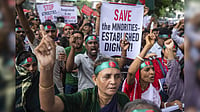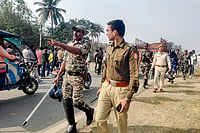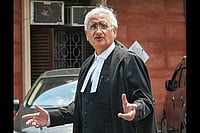It could have been a scene from Modern Times, Charlie Chaplin's spoof on regimented industrial life, or a bizarre Bergman classic. We found ourselves in something between an open-air jail and a medieval maze. After the entrance gate clanked shut behind us, we faced a long, narrow winding pathway, fenced on both sides by tall metal pipes dug into the ground. We walked through it single-file; only one person could squeeze through at a time. We had to stay on the path as it twisted and turned over the contours of a bare hillock. There were no junctions, no side paths. Nor any signs or guides to inform us precisely where we were. A file of pilgrims hurried through ahead; heads bowed, clutching cotton clothing tightly to them; it was cold and misty. We paused briefly twice; once to gaze at a squat weed-covered structure just above the ground; then before a well-lit niche with pujari in attendance. We filed out in depressed silence.
Yet this bleak spot is the centre around which national politics is again revolving. The weed-covered remains are all that remains of the 16th century Babri Masjid; demolished by kar sevaks on December 6, 1992. The idol, installed two days after the demolition, represents the belief that this is the spot where Ram was born. Beyond the area protected by steel pipes, rows of semi-permanent huts have come up to accommodate hundreds of policemen. The area is large enough for a grand mosque to be built on the site of Babri, with an equally grand Ram temple beside it—a perfect solution for a dispute that has cost the country so dear. Agreement between Hindu and Muslim religious representatives on such a plan has been near at times. But politicians more concerned with communal votebanks have come in the way, aided by newspapers for whom communal strife means higher circulation figures. Religious tension has been kept taut from long before the tragic events of December 6, 1992.
I Witness

I Witness
I Witness
Published At:
MOST POPULAR
WATCH
MORE FROM THE AUTHOR
×



















